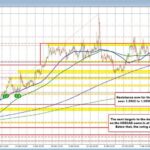
USD/CAD Currency Pair: Navigating the Bearish Trend and Market Outlook
Tháng 4 11, 2025April 2025 UMich Consumer Sentiment: Anxiety Grows Amid Rising Inflation
Tháng 4 11, 2025Understanding the Recent Decline in Consumer Sentiment: Insights from April 2023 Data
The recent consumer sentiment data for April paints a concerning picture of the economic landscape in the United States. According to the University of Michigan’s preliminary consumer sentiment index, the index plummeted to 50.8, significantly falling short of the target forecast of 54.5. This decline marks a continuation of a troubling trend observed over the previous months; March’s reading was 57.0, down from 64.7 in February. Such fluctuations in consumer sentiment are critical indicators of economic health, reflecting how consumers feel about their financial situations, which can, in turn, dictate their spending behaviors.
The Impact of Economic Uncertainties on Consumer Sentiment
Consumer sentiment is inherently tied to multiple economic indicators, and the sharp drop in the index signifies increasing unease among consumers about their financial futures. Several factors appear to contribute to this decline, with inflation being a primary concern. Specifically, year-ahead inflation expectations have surged, previously reaching a high of 5.0%. Rising prices inevitably lead consumers to become more cautious about their spending, which is particularly troubling given that consumer spending is a vital driver of the U.S. economy. For further insights on the investment landscape influenced by these economic pressures, one may refer to this blog on key investment mistakes to avoid.
The sentiment indices not only reflect current attitudes but also encompass expectations of future economic conditions. This is crucial since it highlights how consumers are adjusting their expectations in face of ongoing economic uncertainties. Tariffs and heightened inflation concerns are creating an environment of skepticism, adversely influencing how consumers perceive their financial stability. As inflation rates climb, more consumers may rethink their spending habits, opting for savings rather than expenditures, which can slow economic growth. Recognizing psychological missteps in investment can also be beneficial during these times; for example, avoiding certain psychological traps is discussed here.
Contrasting Indicators: A Glimpse at Consumer Expectations
Interestingly, the recent data juxtaposes a stark contrast with the Michigan Consumer Expectations index, which had anticipated an uptick in optimism despite not aligning directly with the preliminary sentiment figures. This discrepancy suggests a nuanced economic environment. Consumers may hold mixed feelings, where expectations of the future could display optimism even in the face of current challenges impacting their day-to-day lives.
It’s crucial to understand that consumer sentiment does not operate in a vacuum. The overall economic mood appears increasingly volatile, affecting both stock and bond markets. As market movements often react to consumer confidence levels, a falling sentiment index could lead to noticeable ripples across various sectors of the economy. Additionally, the intricacies of international trade relations, such as those discussed in relation to U.S.-China tensions, further underline the interconnected economic landscape that influences consumer sentiment and financial strategies. For a closer look at these strategic moves by China, you can explore this insightful blog.
In conclusion, the recent data on consumer sentiment indicates a significant drop from previous months, accentuated by growing inflation concerns and economic uncertainties. This shift in consumer attitude not only signals potential changes in consumer spending behaviors but also underlines the intricate relationship between inflation, market performance, and consumer confidence. Stakeholders in the economy, from policymakers to investors, should closely monitor these trends, understanding that consumer sentiment is a critical barometer of economic health and future financial forecasts.
